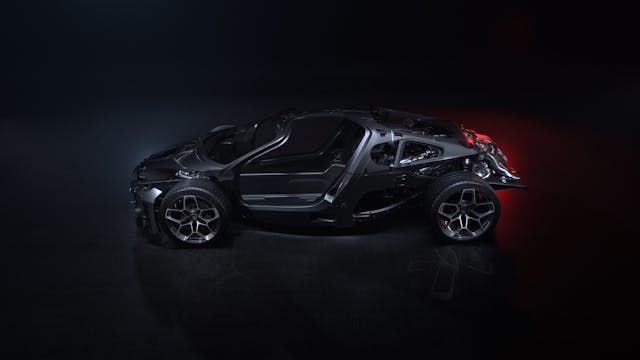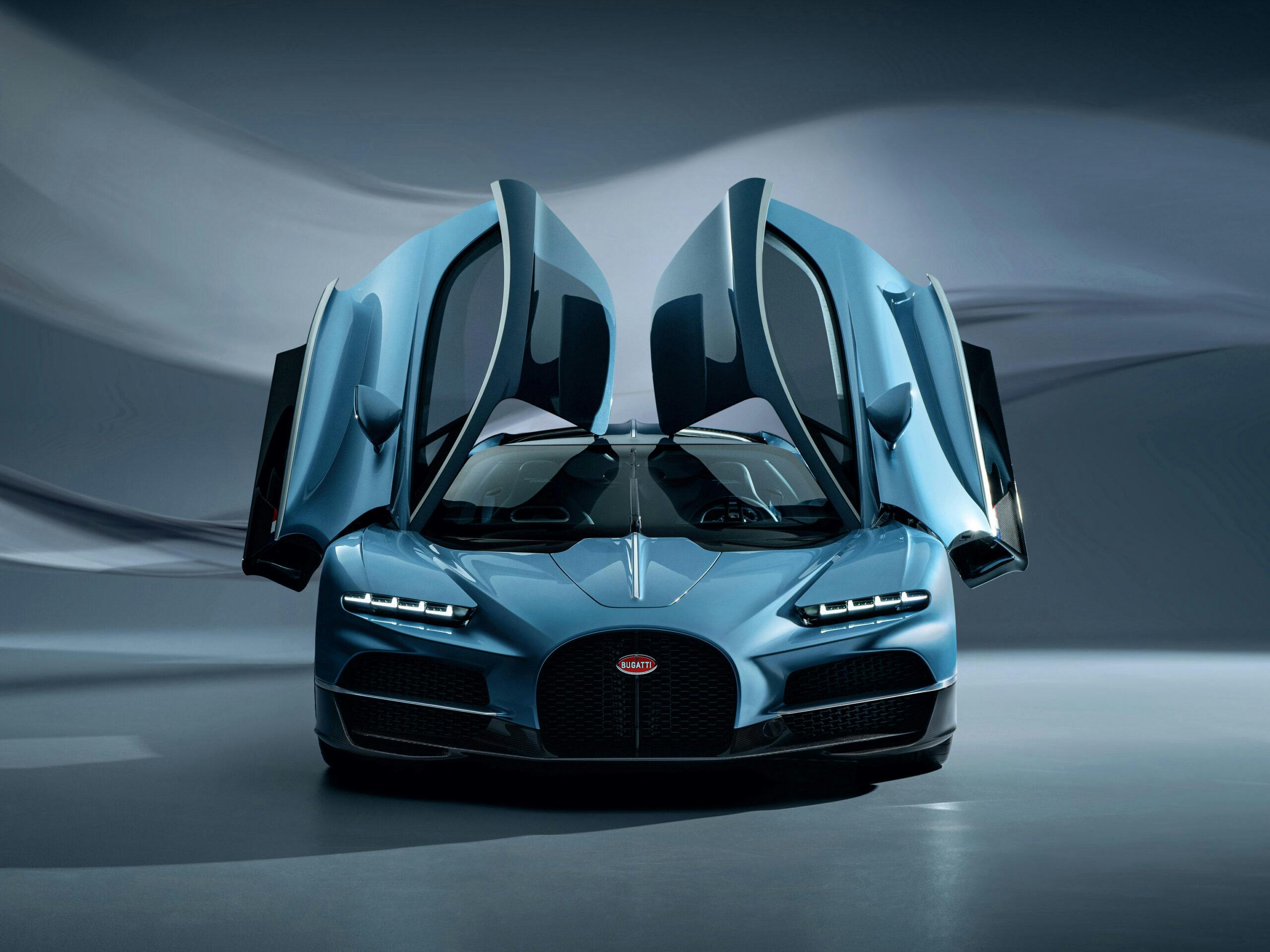Media | Articles
Bugatti’s Tourbillon Is a Masterclass in Design Execution
I must admit that, until recently, I wouldn’t have put a dime on Bugatti’s future prospects. After all, Ferdinand Piëch, the legendary mastermind behind the French Marque’s renaissance under VW, is gone. Since then, the VW Group has been shifting its focus to electric vehicles, which have turned 1000-plus horsepower ratings from a rare engineering triumph into something almost mundane.
There seemed to be nowhere left to go for Bugatti in this brave new world, and, observed in this light, the formation of the Bugatti-Rimac joint venture in 2021 strengthened this impression. At least to my eyes, it looked more like an elegant way for VW’s management to wash its hands of an unwanted relic from the Piech era than a credible way forward.
Well, one look at the new Bugatti Tourbillon is enough to see just how far off the mark I was. Not only does it still pack an internal combustion engine, and a genuinely epic one at that, but it may well be the best-looking Bugatti made since World War II.



The Bugatti Tourbillon can be considered a textbook example of the importance of proportions and detail execution in car design. The car is all-new, but in terms of overall concept and design language, it doesn’t break from the mold that was cast two decades ago with the Veyron. That big, sweeping curve on the side, inspired by Jean Bugatti’s 1930s creations, is still there, neatly cutting the car’s volume in two aft of the doors. And so is the trademark “horseshoe” grille, bigger and more prominent than before. So what sets the Tourbillon apart, especially compared to the Chiron it replaces, isn’t so much novel ideas but judicious, painstaking execution.
I’ll never tire of repeating that beauty in car design begins with proportions. The tools available to designers have changed beyond recognition, but Harley Earl’s old mantra “longer, lower, wider” remains as valid today as it did when cars still came with running boards. The Tourbillon’s overall footprint hasn’t changed dramatically compared to the Chiron, but, you guessed it, it’s longer, wider, and, most importantly, lower. Now, I get that 23 millimeters, or a little under an inch, may not sound like much, and in absolute terms, it certainly isn’t. Still, it makes quite a difference on a vehicle that sits lower than your average crossover’s door handles.
Marketplace
Buy and sell classics with confidence

But the change that’s by far the most transformative compared to the Tourbillon’s predecessor is the increased tumblehome. In car design jargon, that’s the term used to describe the way a car’s body tapers upwards toward the roof. A van has little or no tumblehome at all, while supercars sit at the opposite end of the scale, with their wide tracks and snug two-seater cabins. The Tourbillon’s new driveline configuration—with the electric motors up front eliminating the mechanical bits in the tunnel between the passengers—allowed Bugatti’s engineers to place the seats closer to the car’s centerline, giving the designers room to sculpt the Tourbillon’s bodysides in a way that hadn’t been possible before. And that’s great news indeed, because despite being one of the fastest cars on the planet, the Chiron looked as graceful as a charging rhino.


In contrast, the new Tourbillon looks athletic, like a beast ready to pounce. Its perfectly sculpted fenders flare out from the sides, giving the car a sexy “Coke bottle” shape. Every square inch of the Toubillon’s body panels is a testament to the care and attention Bugatti’s design team lavished on the car, and the result is an interplay of light, shadow, and reflections that’s almost hypnotic.



Another key element of the Tourbillon’s design is the central “spine,” a motif inspired by the legendary 57S Atlantic. That in itself is nothing new; Bugatti’s stylists have referenced the Atlantic before, and this certainly won’t be the last time they do so. However, as with every aspect of the Tourbillon’s design, it’s the execution that stands out. The shape of the two openings over the engine compartment neatly homages the contours of the Atlantic’s rear windows without being a straight copy. At the same time, integrating the third brake light into it gives the central spine a clear function and the whole car a highly recognizable light signature. Lastly, the idea of continuing the “spine” theme on the windscreen by setting the single wiper’s rest position in the middle of it is brilliant in its simplicity.



Still, having spent most of my roughly ten years in car design working on interiors, it’s what lies behind the Tourbillon’s doors that has me truly fascinated. Bugatti’s exterior designers did a fine job, but the team who worked on the interior knocked it out of the park.
The Tourbillon’s cabin looks invitingly cozy and uncluttered, but once again, it’s the detail execution that elevates it above and beyond anything we’ve seen before. Unencumbered by cost constraints, Bugatti’s interior designers took the mechanical watchmaking theme that inspired the whole project and ran with it. The result is a genuinely stunning instrument cluster and a delightful set of secondary controls that I fully expect to become a fixture of designers’ mood boards for years to come.




It’s a refreshing break from the car industry’s ongoing infatuation with touchscreen interfaces, but what’s perhaps more important is how it’s all so perfectly in keeping with Ettore Bugatti’s ethos. The marque’s eponymous founder was famously obsessed with the way every component of his cars looked, down to the very last bolt. Excellence was a prerequisite rather than a target, and designing the finest instrument cluster to ever grace a vehicle is an excellent way for Bugatti’s designers to remind a Tourbillon’s driver that’s still the case.

I’ve never been much interested in watches, and it’s rare for me to get excited about multi-million-dollar hypercars, especially when they aren’t made in Maranello. But I do care about exquisite automobile design, and I’m glad to say that the Bugatti Tourbillon really is one for the ages. Everyone involved in this project, from CEO Mate Rimac down to the last technician, can rest easy knowing they’ve done Ettore proud.
***
Check out the Hagerty Media homepage so you don’t miss a single story, or better yet, bookmark it. To get our best stories delivered right to your inbox, subscribe to our newsletters.




















































A designer who has “never been much interested in watches” is curious to me, haute horology being one of the pinnacles of the design world. The marriage between watch and car makers has been a symbiotic relationship for many decades.
I think the design is pretty good. The interior is great except for the tiny ipad tacked on in the dash. It looks completely out of place.